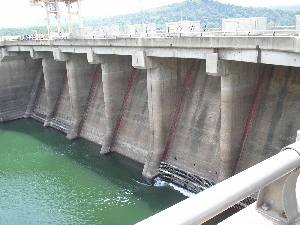Unless there is divine intervention, the Akosombo Dam, Ghana’s economic heartbeat and most valuable asset will be closed down next week.
This follows the alarming rate of the daily drop in the level of water that turns the turbines to generate electricity for domestic and industrial use. Mr. Kwesi Amoako, the Plant Manager of VRA confirmed on Citi FM on Wednesday that there’s been a 0.03 daily drop in the water level for sometime now, which left the dam with just 235.24 feet as at Wednesday, July 10.
At this level, the water was only strong enough to turn two turbines, which has been the case for almost a year now. The minimum operating level of the dam is 240 feet; below this, the dam is at worse, operating at what Mr. Amoako called “the extreme minimum.”At the current level of 235.24, the dam is operating at its lowest level since 1984, when the water dropped to 235.76. Unlike in 1984 when there was a countrywide drought, this time the rains are falling alright, but the inflows are still too low for the dam to operate at full capacity. The Plant Manager said currently only two turbines are in use during week days, while one is switched on during weekends with power imports from Cote d’Ivoire to beef it up. He says if the trend continues, the VRA will be compelled to operate one machine, which can generate only 135 megawatts, which could worsen the load shedding. Available information indicate that the Akosombo Dam had the capacity to generate1,020 megawatts. But it is currently producing a mere 270 megawatts with two turbines. The fear is that if the water level does not improve by next Wednesday, the dam could be shut down. But Mr. Amoako put on a brave face in trying to convince the public that all is well with the dam. When asked at which point the dam would be shut down he said “until signs indicate that we are overstretching the machines beyond their design limit.” He unconvincingly explained that the dam will bounce back by the end of July when the rains are expected to hit the highest point. Against all odds, the Plant Manager remained optimistic that the dam could still operate on two machines; even worse, operate on one machine during weekends. “We have been doing this as and when it becomes necessary. We believe that sooner than later, there will be a turnaround, Mr. Amoako assured Ghanaians. Asked to be definite about the exact time the dam may have to shut down, he said the two turbines that are currently operating are at a lower elevation and can operate below the extreme minimum of 235.00. But considering the fact that for the past one week, the water level has been dropping by 0.03 feet, it may take divine intervention to save the dam from total collapse. It is not for nothing that the Akosombo Dam, arguably the most famous landmark of Ghana’s independence has been embossed on the back of the One Ghana cedi note. It was due to its immense contribution to Ghana’s economic growth. But as things stand now, the significance of Akosombo, in the national development agenda is beginning to wane, a fact Mr. Amoako quite reluctantly agreed with. So at a point Ghanaians may have to learn to live without our beloved Akosombo. Perhaps, when that happens, load shedding, as in Nigeria will become a permanent feature of Ghanaian lives, considering the fact that current long and short term plans are not giving a clear indication of when the crisis will end. Even as Akosombo struggles, plans are afoot to construct the Bui Dam, which will also depend on the Black and White Volta Rivers. The Bagri River is the source of the Volta River and has been the source of potential conflict between Ghana and Burkina Faso; but for years the two countries have failed to map out a strategy for mutual use of the water. Though government officials are unwilling to publicly admit that Ghana is losing out to Burkina Faso in harnessing the Black and White Volta Rivers, it is clear that the decision of that country to construct a dam on the Bagri River is the cause of Akosombo’s distress. So is hydroelectric power a solution to Ghana’s long term energy needs? The answer depends on who is talking.

















